Find more information in the General Comments section of the assessment
Find more information in the Rating Validity tab of the assessment
- See More
- See More
- See More
- See More
- Good
- Adequate
- Marginal
- Weak
- Poor
 Passenger
Passenger
 Driver
Driver
 Rear Passenger
Rear Passenger
 Driver
Driver
 Car
Car
 Pole
Pole
 Rear Seat
Rear Seat
 Front Seat
Front Seat
- Good
- Adequate
- Marginal
- Weak
- Poor


Passenger
outboard
center
outboard
Fitted to the vehicle as standard
Not fitted to the test vehicle but available as option
Not Available
-
Infants up to 13 kg
-
Infants and toddlers up to 18 kg
-
Toddlers from 9 to 18 kg
-
Toddlers over 18 kg
Easy
Difficult
Safety critical
Not allowed
| Seat Position | ||||||
|---|---|---|---|---|---|---|
| Front | 2nd row | 3rd row | ||||
| Passenger | Left | center | Right | Left | Right | |
| Maxi Cosi Cabriofix (Belt) | ||||||
| Britax Römer King Plus (Belt) | ||||||
| Britax Römer Duo Plus (ISOFIX) | ||||||
| Britax Römer KidFix (Belt) | ||||||
| Maxi Cosi Cabriofix & EasyFix (Belt) | ||||||
| Maxi Cosi Cabriofix & EasyFix (ISOFIX) | ||||||
| BeSafe iZi Kid X3 ISOfix (ISOFIX) | ||||||
| Maxi Cosi Pearl & Familyfix (ISOFIX) | ||||||
| Britax Römer KidFix (ISOFIX) | ||||||
Easy
Difficult
Safety critical
Not allowed
Both child dummies were sat in rearward-facing restraints and the Espace scored maximum points for its protection of the 1½ and 3 year infants in the dynamic tests. In the side impact, both dummies were properly contained within the protective shells of their restraints, minimising the likelihood of head contact with parts of the vehicle interior. The front passenger airbag can be disabled to allow a rearward-facing restraint to be used in that seating position. Clear information is provided to the driver regarding the status of the airbag and the system was rewarded. All of the restraint types for which the Espace is designed could be properly installed and accommodated in the vehicle.
- Good
- Adequate
- Marginal
- Weak
- Poor

Head Impact 13.4 Pts
Pelvis Impact 6.0 Pts
Leg Impact 6.0 Pts
The bumper provided predominantly good protection to pedestrians' legs and scored maximum points for its protection of the pelvis area. The bonnet surface showed adequate protection to the head of a struck pedestrian in most areas with some good performance towards the centre and poor results only on the stiff windscreen pillars.
- Good
- Adequate
- Marginal
- Weak
- Poor
| System Name | Over Speed Prevention System |
| Speed Limit Information Function | Camera & Map |
| Warning Function | System advised |
| Speed Limitation Function | System advised |
| System Name | ESP | |
| Performance | ||
| Vehicle Yaw Rate @ COS + 1.00 s | 8.7% | meets ECE requirements |
| Vehicle Yaw Rate @ COS + 1.75 s | 5.4% | meets ECE requirements |
| Lateral Displacement @ BOS + 1.07 s | 3.05 m | meets ECE requirements |
| Applies To | All seats | ||
| Warning | Driver Seat | Front Passenger(s) | Rear Passenger(s) |
| Visual | |||
| Audible | |||
|
|||
| System Name | Lane Departure Warning |
| Type | Lane Departure Warning |
| Operational From | 70 km/h |
| Warning | Audible & Visual |
| Performance | |
|
LDW Confirmation Test
|
Pass |
| Type | Forward Collision Warning with Auto-Brake | |||
| Operational From | 30 km/h | |||
| Additional Information | Default On | |||
| Performance | | ||||
| Autobrake Function Only | Driver reacts to warning | |||
| Operational Speed | 30-140 km/h | 30-140 km/h | ||
| Approaching a slower moving car | Crash avoided up to 0km/h.Crash speed reduced up to 0km/h. | Crash avoided up to 50km/h.Crash speed reduced up to 80km/h. | ||
| Following a car at short distance | ||||
| Car in front brakes gently | Mitigation | Mitigation | ||
| Car in front brakes harshly | Mitigation | Mitigation | ||
| Following a car at long distance | ||||
| Car in front brakes gently | Mitigation | Mitigation | ||
| Car in front brakes harshly | Mitigation | Mitigation | ||
Electronic stability control is standard equipment, along with a seatbelt reminder system for the front and rear seats. The optional 'Over-Speed Protection System' uses a forward-looking camera to recognise speed signs. The information is presented to the driver who can decide whether or not to allow the car to be limited to that maximum speed. The system met Euro NCAP's requirements for such intelligent speed assistance and was given maximum points. An autonomous emergency braking system is also an option that is expected to be fitted to most cars sold. The system operates between 30 and 140km/h and gave marginal performance in Euro NCAP's tests. A lane departure warning system is also available as an option and met Euro NCAP's requirements.
- Specifications
- Safety Equipment
- Videos
- Rating Validity
Specifications
Tested Model Renault Espace
Body Type - 5 door MPV
Year Of Publication 2015
Kerb Weight 1671kg
VIN From Which Rating Applies - applies to all Espaces of the specification tested
Class Large MPV
Safety Equipment
Note: Other equipment may be available on the vehicle but was not considered in the test year.
Fitted to the vehicle as standard
Fitted to the vehicle as option
Not fitted to the test vehicle but available as option
Not Available
Not Applicable
Videos
Rating Validity









Find more information in the General Comments section of the assessment
 Share
Share
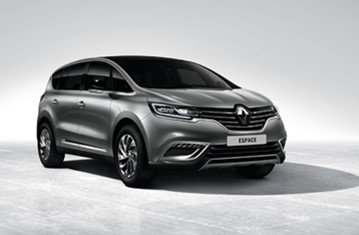
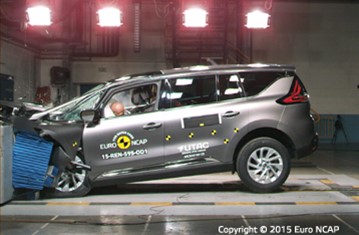
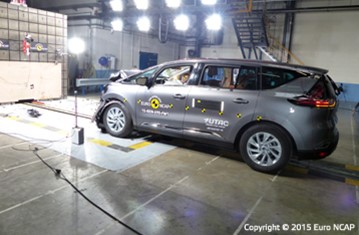
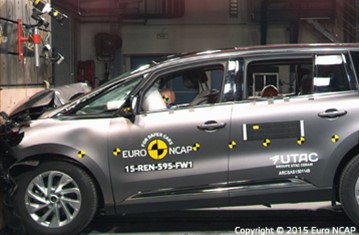

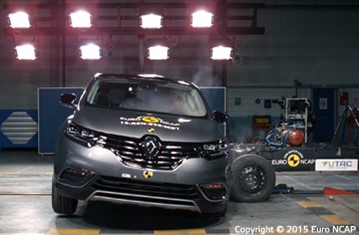

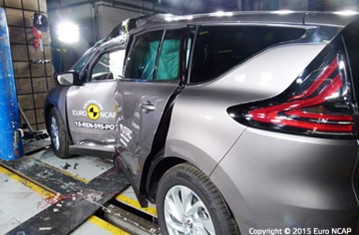



The passenger compartment of the Espace remained stable in the frontal offset test. Dummy readings indicated good protection of the knees and femurs of the driver and passenger. Renault showed that a similar level of protection would be provided on the driver's side to occupants of different sizes and to those sat in different positions. However, on the passenger side, structures in the dashboard presented a risk of injury and the car was penalised. In the full-width rigid wall test, all critical body areas were well protected for the driver and protection of the rear seat occupant was good or adequate. In the side impact barrier test, dummy readings showed good protection of all critical body areas. However, the rear driver's side door opened during the test, presenting a risk of ejection for those in the vehicle and the score was penalised. In the more severe side pole impact, dummy readings of rib compression indicated a marginal level of protection for the chest but protection of other parts of the body was good. Tests on the front seats and head restraints indicated good protection against whiplash injuries in the event of a rear-end collision. A geometric assessment of the rear seats indicated marginal whiplash protection. The Espace's autonomous emergency braking system operates from 30km/h upwards so did not qualify for an assessment of its whiplash protection.